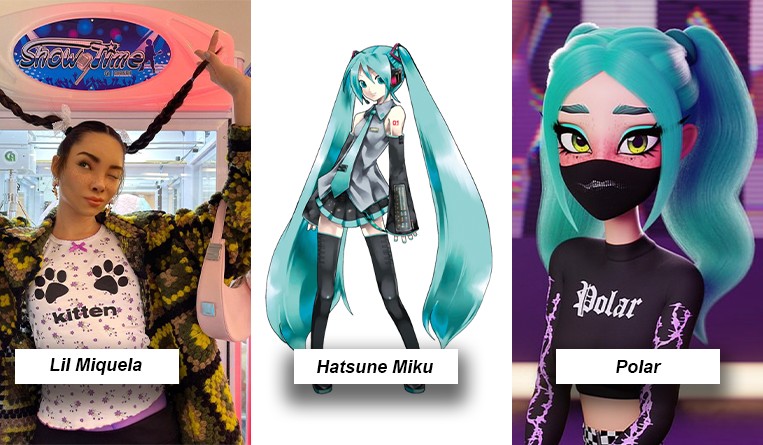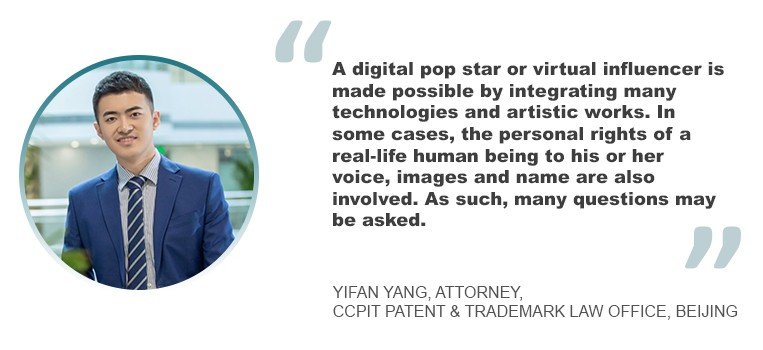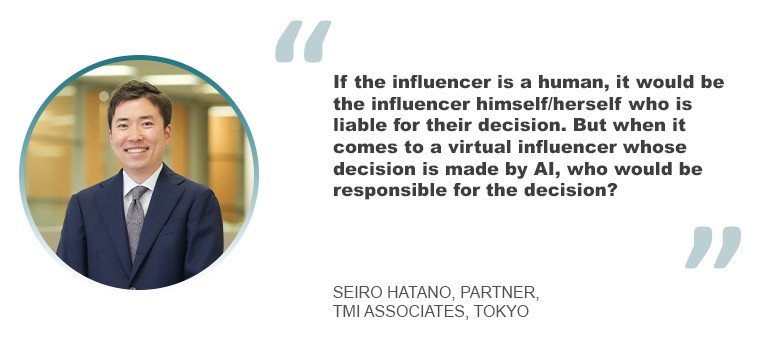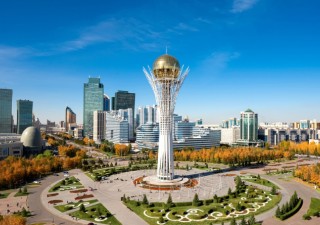Digital celebrities: The reality of IP in a virtual world
31 October 2023

Hatsune Miku, Polar and Lil Miquela each boast large numbers of fans, sold-out concerts and singles atop the pop charts. They share one more trait in common: none of them are real, but are all virtual celebrities.
From loss of revenue to IP misuse, virtual celebrities give rise to significant intellectual property challenges. Espie Angelica A. de Leon addresses these challenges and the measures to take.
What do Hatsune Miku, Polar and Lil Miquela have in common?
I guess my question should first have been: “Are you familiar with them?”
Hatsune Miku is one of Japan’s hottest pop idols. She has more than 900,000 fans on Facebook and has sold out concerts in Tokyo, Hong Kong, Singapore, Taipei and L.A.
Polar is the English pop star behind the hit song Thinking About You. She has a huge following on TikTok and her appearances have resulted in millions of views on YouTube.
Meanwhile, Lil Miquela is a singer, model and influencer with 2.7 million followers on Instagram as of October 2023. She is also active on Twitter, Tumblr, YouTubeand TikTok. Among her singles are Not Mine, Over You, Money and Sleeping In. In 2018, Lil Miquela collaborated with Samsung for the company’s #teamgalaxy campaign.

Today’s digital celebrities often have their own social media pages, making them subject to the same intellectual property laws as their real-life counterparts.
However, the three’s common thread isn’t just being celebrity performers with gazillions of fans – they are not real either. You read that right: Hatsune Miku, Polar and Lil Miquela are not real. They’re virtual celebrities; in other words, they are pop artists and influencers in the digital world, including the metaverse. Lil Miquela, arguably the most realistic-looking of the three, says on her Insta bio that she’s a “19-year-old robot living in LA.”
Digital or virtual celebrities are “personalities” created using CGI technology and AI. They possess human-like attributes, from their looks and how they dress to their movements. In the case of virtual pop artists, they can sing and dance like real performers. To enable them to move like real people, human actors are hired to work alongside the technical team behind these CGI celebrities to achieve motion capture or mo-cap.
These CGI-made and AI-powered personalities, some of whom appear as holograms, were created for a purpose. In particular, virtual influencers were created by companies to be their spokesperson, ambassador or endorser. Among the numerous brands that have joined in the virtual influencer marketing bandwagon by creating and partnering with virtual personalities are Samsung, Renault, Dior, L’Oréal, Balenciaga, Calvin Klein, Prada and streetwear brands.
Hatsune Miku is not the only virtual personality from Japan, or from Asia for that matter. Japan also has the world’s first virtual fashion model Imma and her “younger brother” and fellow fashion model Zinn, who both look hyper realistic. Several other virtual influencers include China’s Ayayi and Luo Tianyi, South Korea’s Apoki and the virtual girl band Eternity, Thailand’s Bangkok Naughty Boo and the Philippine’s virtual model Bernila.
Fact is, it is in Asia where the influencer marketing industry is expected to explode.
In a November 2021 Tatler Asia article on Asian virtual influencers in the metaverse, Yerevan, Armenia-based influencer marketing specialist Nick Baklanov said: “We think Asia will be an area of rapid growth in the sector of virtual influencers. Generation Z is the largest group of Internet users in Asia, and it is a digitally adept generation that is highly familiar with social media and all things virtual.”
Consider that scenario. Then, think about it in terms of intellectual property.
“There have been some developments in China related to digital pop stars and virtual influencers in respect of IP matters,” shared Yifan Yang, an attorney at CCPIT Patent & Trademark Law Office in Beijing.
IP challenges in a world of CGI influencers and virtual influencer marketing
“As new social media platforms and technologies emerge, IP owners find it difficult to adapt their strategies and protect their IP on these new platforms. Copying of the content and unauthorized use of trademarks or brand names by the influencers have become rampant. With the vast amount of content being produced and shared online, it can be challenging for IP owners to monitor and enforce their rights effectively,” said Gautam K.M., a partner at Krishnamurthy & Co. (K Law) in Mumbai.

Of course these challenges echo those in the realm of real-life performing artists and influencers, but with additional twists because they involve CGI, AI technologies and human actors. These challenges include:
- Trademark squatting
- Lack of attribution
Another possible misstep by virtual Influencers is failure to give proper credit or attribution to the IP owners of the content they are using. Such scenario can lead to confusion over ownership of the original content and recognition.
- Loss of revenue
“Availability of the IP owner’s content freely can affect the revenue which it could have otherwise earned if the views were not diverted by the infringing content,” explained Gautam.
- Misuse or alteration of their IP
Digital or virtual influencers may alter, modify or manipulate copyrighted content to create their own content or post. By doing this, they may end up damaging the reputation of the original work’s IP owner.
- Unwanted associations
Using an IP owner’s original content may also cause confusion of association between the IP owner and the virtual influencer in the viewers’ minds. Under such circumstances, the IP owner’s reputation may be affected. In turn, this could cause potential claims against the IP owner for the acts and omissions of the influencer.
- Unauthorized endorsements
Another dilemma faced by IP owners is when virtual influencers use a brand’s logo or trademark without authorization as a form of endorsement or to suggest the influencer’s affiliation with the brand. This may also lead to confusion among consumers.
- Inconsistent messaging
“Influencers may inadvertently or intentionally misrepresent a brand’s products or services, leading to misinformation,” said Gautam.
- Uncertainties in the realm of copyright
“There have been some developments in China related to digital pop stars and virtual influencers in respect of IP matters,” shared Yifan Yang, an attorney at CCPIT Patent & Trademark Law Office in Beijing.

“A digital pop star or virtual influencer is made possible by integrating many technologies and artistic works. In some cases, the personal rights of a real-life human being to his or her voice, images and name are also involved. As such, many questions may be asked,” said Yang.
One of these is: Who owns these digital pop stars and virtual influencers, or at least their economic benefits?
There are multiple aspects of digital celebrities that may be protected as copyright. These include the visual image itself, the underlying program or algorithms, the user interface and the design, among many others.
In China, the problem lies in that, unlike the case of a movie or television program, the country’s copyright law does not provide for an umbrella type of work covering all these different aspects. “Therefore, without agreements between relevant parties, it is legally challenging to determine who owns a digital pop star or virtual influencer and how he/she would exercise control over it,” explained Yang.
In the case of an AI-powered virtual personality generating copyrightable content, the foremost question is: Does whoever owns the digital pop star or virtual influencer automatically own the copyright to that content?
According to Yang, this is the subject of an ongoing debate in the Chinese legal community, as “there are two conflicting rulings from different Chinese courts where one says the AI-generated content is a copyrighted work and the copyright belongs to the operator of the AI, while the other says neither the operators nor the users of the AI should be granted the copyright of the AI-generated work. But, the latter court did hold that the users of the AI have civil interests in that work.”
Another question is: Who is responsible for an act of IP infringement caused by a virtual pop artist or influencer when it provides content using AI without control over the provider?

Seiro Hatano, a partner at TMI Associates in Tokyo, said “it might get unclear who should be responsible for the ‘act’ of those influencers.”
He explained: “If the influencer is a human, it would be the influencer himself/herself who is liable for their decision. But when it comes to a virtual influencer whose decision is made by AI, who would be responsible for the decision? If the provider of the virtual influencer also has control over the algorithm of AI, it might be easy to have the provider take responsibility. But if the provider does not have any skill and ability to have control over the AI, the responsibility might become unclear.”
Now comes the follow up question: How to avoid infringement of other people’s IP rights?
“In the development of a digital pop star or virtual influencer, there are risks of infringement against other people’s IP rights, such as patents in design, copyrights in computer software or artistic works or even figurative or 3D trademarks,” said Yang. “In the performance of a digital pop star or virtual influencer, there are also risks of infringement of other people’s IP, especially songs, dances and others. Since many digital pop stars or virtual influencers are not powered by AI or algorithms but by actors behind the scenes, there are also potential disputes as to whether the actors are the performers who enjoy the related rights.”
Navigating these IP challenges
Our interviewees list the following measures for IP rights owners and creators of virtual personalities to prevent these problems from happening or at least help them navigate the challenges if and when they do occur:
For IP rights owners:
- Define terms of use and licensing agreements
This should be done on their websites, if any, and should include guidelines for influencers’ use of their IP.
- Make use of established mechanisms put in place by several platforms to address and resolve IP disputes.
“For instance, YouTube has implemented a ‘Content ID’ system, which is a digital fingerprinting system developed by Google to aid copyright owners in identifying, managing and protecting their content by scanning new content uploaded to the platform, against copyrighted content stored within the Content ID,” explained Gautam, adding that such mechanisms often aid in removing infringing content.
- Have written agreements with all relevant parties regarding IP rights involved.
Due diligence must be conducted. Likewise, written permission must be obtained from all relevant parties regarding existing IP rights involved. These things have to be done prior to the development of the virtual celebrities and their eventual launching.
“In development, agreements must be made with developers and the actors behind the scenes regarding the ownership of the results of their work and/or contributions,” said Yang. “After debuting, it is also necessary to address the copyright ownership issue regarding the original songs, dances or recording of live streaming or performance. A copyright registration certificate is recommended to be obtained.”
- Adopt an all-elements strategy in applying trademarks before unveiling their digital pop stars or virtual influencers.
“Marks that could be applied for include the names, visual images and the voice of the digital pop star or virtual influencer. In addition, rights owners need to apply for trademarks based on their commercialization plan, filing application in classes beyond their current business so as to avoid future disputes when the business expands into those areas,” shared Yang.
- Implement robust monitoring and enforcement strategies by itself and through third-party monitoring agencies
For virtual pop artists and influencers and their creators:
- Have proper licence, permission and authorization
“This is unless usage of the copyrighted content qualifies for a copyright exception, such as fair use, irrespective of such copyrighted work being freely available on the internet,” noted Gautam.
Fair use applies to specific instances, such as when the copyrighted work is used for educational information or constructive critique. Such instances should be non-commercial in nature to qualify as fair use.
Herein lies the problem, though. Gautam explained: “Determining the boundary between commercial and non-commercial usage becomes intricate for influencers, as some may substantiate that their content serves authentic criticism or review purposes. Conversely, certain scenarios might involve endorsing another product or brand concurrently with critiquing the copyright owner’s brand, thereby transforming the activity into a commercial endeavour.”
- Secure written authorization from any brand whose name, trademark, logo or products are showcased in social media posts, blogs, videos or photographs featuring virtual pop idols and influencers.
Without written authorization, using someone else’s trademark may lead to confusion among consumers regarding the origin of goods or services. It may also “dilute” the brand’s distinctiveness.
- Carefully choose a domain name by conducting thorough background checks.
This will help ensure that the desired name is not already registered or infringing upon the IP rights of others.
“In many cases, domain names are also registered as trademarks, provided they meet the necessary conditions for trademark registration. Once registered, the owner of a domain name holds legitimate rights and authority, similar to owners of registered trademarks,” said Gautam.
- Use royalty-free media.
According to Gautam, though royalty-free media is not subject to the same restrictions as other types of IP, it is still best practice to give credit to the creator wherever their content is used. He advised royalty-free media users, however, to always check the usage rights before using any content. “And, do not use any content whose owner cannot be traced,” he added.
- Use works that are available in the public domain.
It seems digital or virtual artists and influencers are here to stay. As their tribe continues to increase, virtual influencer marketing may continue to grow in strength and popularity as well. Asia could well be at the center of it, the region being regarded as the world’s hub for virtual idols in the coming years. With the accompanying IP issues, Asia will hopefully be up for the challenge.






